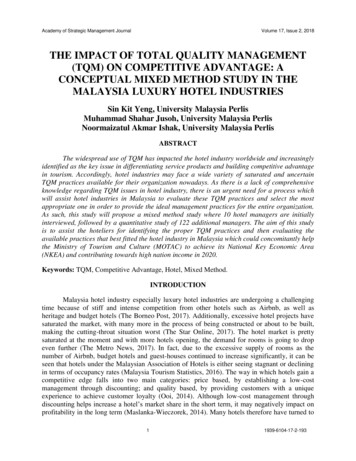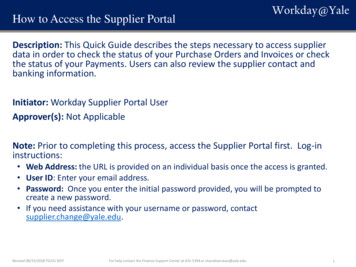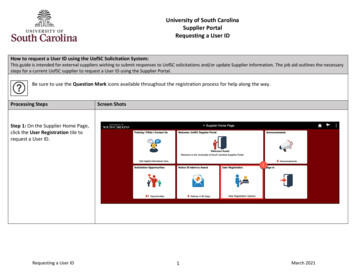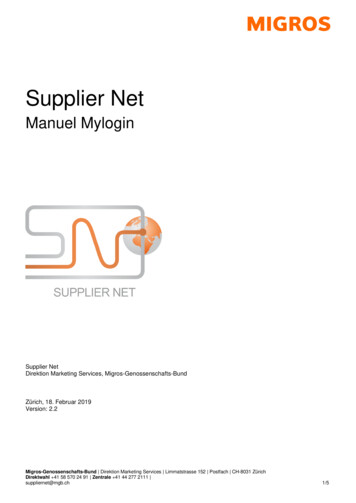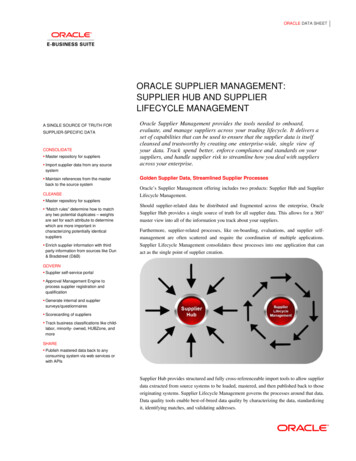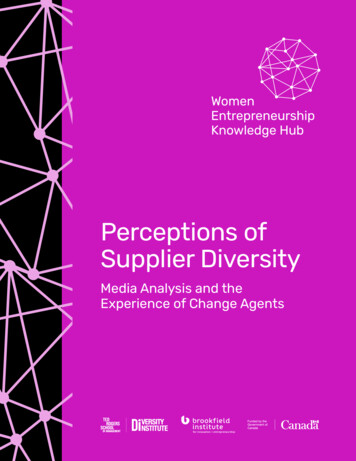
Transcription
Perceptions ofSupplier DiversityMedia Analysis and theExperience of Change Agents1
WEKH.CA@WEKH PCFEDIVERSITYINSTITUTE@RYERSON.CAThe Women Entrepreneurship Knowledge Hub (WEKH) is a national networkand accessible digital platform for sharing research, resources, andleading strategies. With ten regional hubs and a network of more than 250organizations, WEKH is designed to address the needs of diverse womenentrepreneurs across regions and across sectors. In response to COVID-19,WEKH adopted an agitator role connecting women entrepreneurs andsupport organizations across the country and led network calls and trainingsessions. WEKH’s advanced technology platform, powered by Magnet, willenhance the capacity of women entrepreneurs and the organizations whoserve them by linking them to resources and best practices from across thecountry.With the support of the Government of Canada, WEKH will spread itsexpertise from coast to coast to coast, enabling service providers,academics, government, and industry to enhance their support for womenentrepreneurs. Ryerson University’s Diversity Institute, in collaboration withRyerson’s Brookfield Institute for Innovation Entrepreneurship and the TedRogers School of Management, is leading a team of researchers, businesssupport organizations, and key stakeholders to create a more inclusive andsupportive environment to grow women’s entrepreneurship in Canada.AuthorsContributorsPatricia Faison Hewlin, PhDMcGill UniversityJulia CeroneMcGill UniversitySandra Urbina ChangMcGill UniversityHanna OosterveenMcGill UniversityHaoran WangMcGill UniversityAdvisory PartnersFiorella Rojas VizarretaMcGill UniversityTracy JoshuaKelloggZohreh Hassannezhad Chavoushi, PhDRyerson UniversityMary AndersonWomen Business Enterprises CanadaCassandra DorringtonCanadian Aboriginal and Minority Supplier CouncilDate published:November 2021SponsorsThe sponsors of this project include the: Government of Canada, Social Sciences and HumanitiesResearch Council.2
ContentsExecutive SummaryiIntroduction1Overview of Supplier Diversity2Study Methodology11Quantitative Findings12Qualitative Findings15Conclusion and Recommendations28References303
ExecutiveSummaryIn Canada, entrepreneurship by women,racialized people, and Indigenous Peoplesis on a steady rise, but these entrepreneursface unique challenges in successfullycompeting in the marketplace to enter intopublic and private sector contracts. Theconcept of supplier diversity centres on theidea that small and medium-sized enterprises(SMEs) owned by women, IndigenousPeoples, and racialized people have valueadding capabilities not only for the largercorporations they do business with, butalso for the national economy as a whole.1A supplier diversity strategy can offer anorganization numerous benefits, includingopportunities to expand into new markets,increased employee satisfaction due toinclusive practices, increased flexibility inthe supply chain, and the ability to respondto diverse customer needs. While there isan increasing number of supplier diversityprograms, many Canadian organizationsstill lack the policies and mechanisms toproperly incorporate supplier diversity withintheir procurement processes.2 Furthermore,gaps exist between the targets andimplementation of government programs.U.S. and Canada, with a focus on the role andexperience of “change agents” involved insupplier diversity programs.The media analysis shows that supplierdiversity is still a novel topic in Canada,and that compared to the U.S., Canada isfar behind on media exposure surroundingsupplier diversity issues. Furthermore,the majority of media exposure in Canadaconsists of press releases from corporationsthat won supply diversity awards. Becausethere is less focus on entrepreneurship andsmaller players in this coverage, it does notsucceed in generating more interest in SMEsand local communities.The analysis of qualitative interview datafocuses on two main areas: supplier diversitychampions or “change agents” (professionalswho promote supplier diversity in theirindustries and sectors), and “supplierdiversity programs” themselves. The “changeagents” section of this report focuses on theexperiences and perceptions of the peoplechampioning supplier diversity in their field,including their roles and responsibilities,motivations, challenges, characteristics,and impact. In interviews, change agentsdescribed their responsibilities as including,but not limited to, mentoring others in thefield, networking to expand supplier diversityawareness, creating economic opportunitiesfor diverse suppliers, and connectingprocurement to social impact. They tend tobe motivated by core values of fairness anddiversity, self-identification with the cause,and an awareness of the potential impactsfor both businesses and communities. Theseindividuals tend to enter their line of work byThis report outlines a two-part study onperceptions and attitudes toward supplierdiversity. First, the report provides acomparative analysis of how topics relatedto supplier diversity are covered by the massmedia and at procurement conferencesin the United States and Canada. Second,the report highlights key takeaways from aqualitative analysis of data from 27 in-depthinterviews with corporate directors, leadersof non-profit organizations, and legislatorsfrom the supplier diversity ecosystem in thei
volunteering or taking part-time and full-timejobs, leveraging their transferrable skills, andidentifying a need and a potential to fill it.However, supplier diversity champions reportseveral barriers, such as lack of informationand awareness about supplier diversityprograms, misunderstandings of the programas discrimination or preferential treatment,aversion to perceived risks around changingpractices, and hesitation among suppliers toself-identify with underrepresented groups.These dynamics create challenges whenexecuting supplier diversity programs.However, supplier diversity change agentsface several challenges as well, including alack of awareness around supplier diversityprograms, as well as difficulties influencingstakeholders, obtaining and retainingbudget allocations for supplier diversityprograms, establishing relationships withnew suppliers, and accessing a limited supplyof diverse suppliers. Personal metrics thatchange agents use to measure their impactinclude recognition, such as invitations toprocurement conferences, and changingperspectives about supplier diversity in thecommunity.Effective practices in successful supplierdiversity programs include buildingpartnerships among suppliers andorganizations, expanding the program toother supplier tiers, implementing mentorshipprograms to support both entrepreneursand change agents, increasing both internaland external dialogue and engagement,analyzing data to improve understandings,and carrying out development programsfor suppliers. However, there is room forimprovement when it comes to processes foracquiring new suppliers. Nonetheless, thereare various supports available from NGOs,industry actors, stakeholders internal to anorganization, and formal training programs.When analyzing supplier diversity programs,qualitative data reveals that these programscan benefit organizations in several ways.A supplier diversity program can openthe door to new high-quality suppliers,improve an organization’s brand value, andultimately lead to better performance byfostering innovation and lowering costs. Ona larger scale, supplier diversity programshelp promote economic development incommunities by feeding new and betterbusinesses into the community’s ecosystem.When implementing a supplier diversityprogram, key factors for success includecorporate alignment on overarching goals,buy-in at all levels of an organization(including executive leadership), effectivecommunication both internally and throughoutreach, and adoption of best practices.Finally, evaluating the impact of a supplierdiversity program allows organizations todetermine the effectiveness of their programsand adjust their practices in an informedway. Key metrics for measuring the impactof supplier diversity programs include spendanalysis, number of suppliers, applicationopportunities (the number of opportunitiescreated for suppliers to compete and thenumber that were successful), and growth inthe number of employees of a supplier.ii
IntroductionCanada has the second highest level ofstarting a business in the world,3,4 andentrepreneurship by women, racializedpeople, and Indigenous Peoples is on a steadyrise.5,6 At the same time, women, Indigenous,and racialized entrepreneurs face uniquechallenges in successfully competing inthe marketplace to gain access to capitaland entry into public and private sectorcontracts. These entrepreneurs often formstrategic alliances that facilitate authenticityand alignment with unique cultural andcommunity-based ties that shape decisionmaking and entrepreneurial motivationThis report outlines a two-part study onperceptions and attitudes toward supplierdiversity. First, the report provides acomparative analysis of how topics relatedto supplier diversity are covered by the massmedia in the United States and Canada.Second, the report highlights key takeawaysfrom an analysis of qualitative data from 27in-depth interviews with corporate directors,leaders of non-profit organizations, andlegislators in the supplier diversity ecosystemin the U.S. and Canada, with a focus on therole and experience of “change agents”(individuals who are tasked to promote andimplement initiatives that directly benefitthe success of diverse suppliers) involved insupplier diversity programs.Supplier diversity programs aim to encouragethe purchasing of goods and services fromfirms owned by women, Indigenous Peoples,and racialized people,7 and these programsare steadily increasing in Canada. However,many Canadian organizations still lack thepolicies and mechanisms (e.g., diversesupplier networks) to properly incorporatesupplier diversity within their procurementprocesses.8 There are also gaps between thetargets that have been set for governmentprograms and their implementation. Ingeneral, supplier diversity programs arebetter established in the U.S. than in Canada.91
Overview ofSupplier Diversitysupported by more than a single supplier,as the tier one supplier that supplies a largecorporation is in turn supplied by a tier twosupplier, who may be themselves supplied bya tier three supplier, and so on. The suppliersprovide the organization with both direct andindirect products and services, depending onwhich tier the supplier is categorized in. It isimportant to note that the number of suppliertiers can exceed that depicted in Figure 1; forinstance, there could be a tier three as well asa tier four supplier.11The supply chainTo understand supplier diversity, we must firstunderstand the supply chain. A supply chainrefers to the entire process of providing rawmaterials to a manufacturer, manufacturinga product, and finally delivering finishedgoods to consumers using a network ofdistributors.10 The Conference Board ofCanada breaks down the different tiers withina single supply chain within the operations ofa single organization. As depicted in Figure 1,it is possible for each organization to beFIGURE 1The supply chain hierarchyLarge CorporationRequires raw materials or servicesfrom suppliers in order to provide itsproducts to customersTier One SupplierProvides its products and servicesdirectly to the large corporationTier Two SupplierProvides services or productsindirectly to the large corporationthrough a tier one supplierSource: Conference Board of Canada. (2017). The business case for supplier diversity in Canada. plier diversity-diversification fournisseurs-en.pdf2
In this report, we use the term “diversesupplier” to refer to a business that is owned,operated, and controlled at a minimum of 51%by one or more women, Indigenous Peoples,and/or racialized people.12 “Supplier diversity”refers to a strategic business process aimedat providing companies owned by women,Indigenous Peoples, and racialized peopleequal opportunities to become suppliers tomajor corporations across Canada and theU.S.13 It is important to note, however, thatthe United States has been largely successfulin implementing supplier diversity initiativessince the 1960s, while Canada has not.14The concept of supplier diversity centreson the notion that small and mediumsized enterprises (SMEs) owned by women,Indigenous Peoples, and racialized peoplehave value-adding capabilities not only forthe larger corporations they will serve, butalso for the national economy as a whole,and thus they present the opportunity formutually beneficial relationships (or win–winoutcomes) among the involved parties.15Thus, by establishing diversity as a coreprinciple in their supply chain practices,organizations will be able to capitalize on theopportunities for competitive advantage andcommunity engagement.163
Statistics Canada recently estimated theGDP contribution generated by the privatesector by business size from 2003 to 2016.Figure 2 illustrates the trends in the GDPcontributions of small, medium, and largebusinesses during the period of 2003 to2016. As shown, in more recent years (2011 to2016), the contribution has tended to remainstable, with small businesses contributing anaverage of 41.0%, medium-sized businessescontributing an average of 12.8%, and largebusinesses contributing an average of46.2%.18SME demographics andstatistics in CanadaSmall and medium-sized enterprises (SMEs)are majority contributors toward the nation’seconomy. As of December 2019, there werearound 1.23 million employer businessesin Canada. Of these, 97.9% (n 1.2 million)were small businesses, 1.9% (n 22,905)were medium-sized businesses, and 0.2%were large businesses (n 2,978).17 Thecontribution of SMEs to economic productionis measured by the value added to the grossdomestic product (GDP) of the country.FIGURE 2Contribution to GDP by business size, Canada, 7200820092010201120122013201420152016Small Businesses (1–99 Employees)Medium-Sized Businesses (100–499 Employees)Large Businesses (500 Employees)Source: Government of Canada. (2020). Key small business statistics – 2020. https://www.ic.gc.ca/eic/site/061.nsf/eng/h 03126.html4
In addition to their contribution to GDP, SMEscontribute a huge share of net employmentin the country. In 2019, 12.3 million peoplein Canada were hired by private sectorbusinesses, including for 8.4 million (68.8%)employed in small businesses, 2.4 million(19.7%) in medium-sized businesses, and 1.4million (11.5%) in large businesses. Figure 3depicts the distribution of employees inprivate sector businesses.FIGURE 3Distribution of private sector employees by business size, 201980%70%68.8%60%50%40%30%19.7%20%11.5%10%0%Small Businesses (1–99Employees)Medium-SizedLarge Businesses (500 Employees)Businesses (100–499Employees)Source: Government of Canada. (2020). Key small business statistics – 2020. https://www.ic.gc.ca/eic/site/061.nsf/eng/h 03126.html5
The distribution of SME ownership isnot equal among all Canadians, and theunderrepresentation of some groups—classified by Statistics Canada as women,Aboriginal persons, visible minorities, andpersons with a disability—among businessowners is not a new phenomenon. Asdepicted in Figure 4, in 2017, 63.5% of smalland medium-sized enterprises were majorityowned by men, while 15.6% were majorityowned by women. In terms of the other threecategories, 12.2% were owned by racializedpeople [visible minorities], 1.4% by IndigenousPeoples [Aboriginal people], and 0.5% bypersons with disabilities. It is important tonote, however, that the categories of menand women are mutually exclusive in thisaccounting, and thus sum to 100%, while theremaining four categories are not mutuallyexclusive and therefore do not sum to 100%.19FIGURE 4SMEs by majority 5.6%10.0%12.2%5.0%1.4%0.0%MenMen andWomen,EquallyWomenIndigenous RacializedPeoplesPeoplePersonswith aDisabilitySource: Statistics Canada. (2017). Survey on financing and growth of small and medium-sized enterprises. mlAs evidenced by Figure 4, ownership of SMEsis four times higher for men than it is forwomen. Although women start businessesat twice the rate of men, they fail to achievethe same success in terms of growth,20 whichmay be related to the lack of promotionof supplier diversity in Canada, as SMEsowned by women make up less than 5%of all suppliers to Canadian governments(including municipal, provincial, and federal)and corporations.216
there is a significant discrepancy betweenprivate and public sector organizations withregards to the degree to which businessesare implementing supplier diversity initiatives.Specifically, 51% of private sector enterpriseswere implementing supplier diversityprograms, while only 21% of public sectorenterprises were doing the same.25Supplier diversity inCanada todayThe Government of Canada has adoptedpolicies and regulations to facilitate SMEs’involvement in public procurement. Forexample, the Procurement Strategy forIndigenous Business (PSIB) is a nationalinitiative from Indigenous ServicesCanada that increases federal contractingopportunities and improves accessto federal procurement processes forIndigenous businesses.22 Another exampleis Procurement Assistance Canada (PAC)in Public Services and ProcurementCanada (PSPC), which supports SMEs byencouraging their participation in federalgovernment procurement.23 PAC workswith SMEs to resolve their key challengesand constraints by understanding andreducing the barriers that prevent SMEs fromparticipating in federal procurement. Theyadvise government buyers and policymakerson SME concerns and recommendimprovements to procurement tools andprocesses to encourage SME participationin federal procurement. PAC also assists thegovernment in bridging the gap betweensupply and demand by bringing forwardthe concerns and challenges of SMEs in thefederal procurement process.These numbers contrast with findings oncorporations in the United States, signifyingthat there is the potential for a vastexpansion of supplier diversity programs inCanada. In the United States, approximately95% of Fortune 500 companies implementsupplier diversity programs26 as an attemptto exploit new markets and leveragesupplier diversity as a source of competitiveadvantage. Furthermore, Paul Larson’sresearch has found that Canadianorganizations that operate as a subsidiaryor parent company of an American firm aremore likely to implement supplier diversityinitiatives than Canadian organizations thatdo not have any connection to the UnitedStates.27 It is important to note, however,that in the United States, supplier diversityinitiatives are reinforced through legislation.In fact, the Women Business EnterprisesCanada Council (WBE Canada) states thatpublic support from the government “bypromoting the business case for supplierdiversity” is strongly positively correlatedwith the success of these initiatives.The same study also highlights that inthe United States, approximately 80% ofmultinational corporations specifically requirethe implementation of supplier diversityprograms, particularly regarding their tier oneand tier two suppliers.28However, supplier diversity still has notproven to be a widely adopted practicein Canada. In a study conducted by theCanadian Centre for Diversity and Inclusion(CCDI), it is reported that among 242Canadian organizations (including non-profit,government and public sector, healthcare,education, and for-profit companies), only39.1% had implemented a supplier diversityprogram or initiative.24 In another report, theConference Board of Canada reported that7
details the types of innovations implementedby SMEs between 2015 and 2017 byownership category. The graph shows that15.9% of women-owned SMEs presentedinnovation in the realm of marketing, relativeto 13.7% of all SMEs. Additionally, 17.6%of Indigenous-owned SMEs presentedinnovation in organizational methods,relative to 12.6% of all SMEs. Finally, 24.3%of SMEs owned by persons with a disabilityintroduced innovation in their processes,relative to only 12.5% of all SMEs.30 A supplierdiversity strategy can open the door for anorganization to benefit from these innovativesuppliers.Benefits of implementationStudies have shown that organizationsbenefit from the implementation of supplierdiversity programs in the following ways:Improved innovationin the supply chainResearch shows that increased levels ofdiversity can enhance effective innovationin companies.29 The same holds true fordiversity in suppliers. The innovationsimplemented by diverse owners of SMEscan offer new and creative solutions to meeta company’s supply chain needs. DiverseSME owners in Canada have demonstratedinnovation in various areas that can alsostream into bigger companies. Figure 5FIGURE 5SMEs (%) introducing at least one innovation, by type of innovation and majority %12.6%12.5%9.5%8.9%8.2%5%0%MenMen andWomen, zedPeopleOrganizationalPersons with aDisabilityAll SMEsMarketingSource: Statistics Canada. (2017). Survey on financing and growth of small and medium enterprises. ml8
population, slightly more than one-fifth ofCanada’s population. As depicted in Figure 6,this percentage will continue to rise in thelong run, potentially reaching between 24.5%and 30% by 2036.32 This expected perpetualincrease in the diversity of the Canadianpopulation will directly impact expectationsaround workplace practices. In order toreflect the diversity present in the populationand ultimately to meet diverging consumerdemands, organizations must be cognizant ofthe importance of supplier diversity. Throughthe implementation of inclusive and diversitypromoting practices, organizations will bebetter equipped to meet the expectations oftheir consumers, not only in terms of theirbrand image, but also with the diversity ofhigh-quality goods and services that they areable to supply. A supplier diversity strategycan help an organization remain relevant toCanada’s increasingly diverse population.33Improved quality of supply chainAdding diversity to the supply chain enablesan organization to access a rich pool ofsuppliers to leverage in operations. Anincrease in the number of suppliers increasesflexibility and decreases risk in the supplychain. For instance, should a product offeredby one supplier suddenly become unavailable,an organization can easily leverage theofferings of its other suppliers. Thisdiversity among suppliers also presents theorganization with an opportunity to interactwith unfamiliar perspectives, ultimatelyfostering creativity and the possibility ofinnovation.31Ability to respond tocustomer needsCanada’s population is diverse and increasingevery year. The 2016 Census of Populationconducted by Statistics Canada showsthat immigrants account for 21.9% of theFIGURE 6Foreign-born population in Canada, 20020 1062011201620220 12620320 1362Number (millions)PercentageSource: Statistics Canada. (2017). Immigration and ethnocultural diversity: Key results from the 2016 Census. 1025/dq171025b-eng.htm?indid 14428-1&indgeo 09
New opportunitiesFinally, the incorporation of supplier diversityprograms can enable an organization toexpand its sphere of operations into new anduntapped markets. This is due to the factthat, in the long run, a diverse supply chainwill enable the organization to attract newbusiness opportunities. Having access tonew opportunities enables an organization toexpand its operations and financial returns,which, by consequence, also helps feed andsustain the national economy.10
StudyMethodologyThis report explores perceptions of supplierdiversity in Canada through a media analysisand interviews with key informants. Two setsof data were collected between 2018 and2019. First, the research team conducteda media analysis of the difference in mediaexposure of supplier diversity topicsbetween Canada and the U.S. The selectioncriteria included any news articles, opinionpieces, and press releases that containedthe phrase “supplier diversity” or “supplydiversity” and were available online or inthe print media database. Second, the teamcollected data through observation andinterviews. The team engaged in over 100informal communications with procurementprofessionals in online and offline forms andparticipated as observers at three industryevents: WBE Canada’s Automotive AccessEvent & Award ceremony in 2018, CanadianAboriginal and Minority Supplier Council(CAMSC)’s Diversity Procurement Fair in 2018,and Supply Chain Management AssociationOntario (SCMAO)’s Annual Conference in2019. After gaining insight from exploratoryconversations with 69 change agents insupplier diversity from Canada and theUnited States, the research team developeda series of interview questions to exploremore deeply the following key topics relatedto the experience of supplier diversity changeagents: the role of organization (e.g., supportfrom leadership and external partners);implementation of supplier diversityprogramming; factors that motivate changeagents to perform their roles, includingimpact and benefits; and the future ofsupplier diversity in Canada.11
QuantitativeFindingsAlthough the total number of articles thatmentioned “supplier diversity” doubled from2009 to 2017, the majority of media exposurein Canada consists of press releases fromcompanies that have received recognition forsupplier diversity. Canadian media coveragelacks the in-depth and insightful articlesdiscussing action plans and implementationstrategies that are found in U.S. mediacoverage. Furthermore, the growth from2009 to 2018 has not been continuous, andmedia coverage of these topics in Canadacontinues to lag behind coverage in the U.S.The media analysis revealed that supplierdiversity is still a novel topic in the industryin Canada.The main search term used to find mediacoverage was “supplier diversity.” The term“procurement” was not used for the mediaanalysis, as the term “procurement” wouldbe too broad without the term “diversity.” Ifan article is about procurement and relatesto diversity, the term “supplier diversity” willbe typically used in both Canadian and U.S.contexts. Many influential Canadian entitiesuse the term “supplier diversity,” includingthe federal government, corporations, andNGOs. It is unusual to find an article that hasthe words “procurement” and “diversity”but does not mention the term “supplierdiversity.”FIGURE 7Number of articles related to supplier diversity in Canada, 512201620172018
to Canadian media. This demonstratesthat Canada remains in the early stages ofpromoting supplier diversity, with a focus onengagement and education. Figure 8 showsthe number of articles related to supplierdiversity in Canada and the U.S from 2009 to2018.There is a huge gap between media coverageof supplier diversity topics in Canadianand U.S. media, which indicates a lack ofawareness of supplier diversity issues inCanada. One factor that could contribute tothis gap is the difference in size of the mediaindustry in the two countries. However,even after factoring out the size difference,the gap persists. If the two countries hadequal-sized media industries, U.S. mediawould still contain 74% more discussionrelated to supplier diversity topics comparedFIGURE 8Number of articles related to supplier diversity in Canada and the U.S., 00027,10030,00025,00022,800 14U.S.132015716201687320177412018
in the two countries. To achieve this, thewords “CEO” and “C-suite leadership” wereadded to the search for “supplier diversity.”The same exercise was done with the words“entrepreneurship” and “entrepreneur.” Thepercentage of articles related to each topicin coverage from Canada and the U.S. isdisplayed in Figure 9.Another trend revealed in the media analysisis that a quarter of the articles from Canadafocus on entrepreneurship, while thosefrom the U.S. have four times less focus onentrepreneurship. Coverage in both countriesis equally focused on C-level engagement.This finding is based on an analysis ofkeywords. The analysis team chose two keytopics, (1) entrepreneurship and (2) CEOengagement, to understand how differenttopics are reflected in media discussionFIGURE 9Representation of entrepreneurship and C-level involvement in media discussions ofsupplier diversityCanada48%U.S.48%C-Level Involvement16%4%EntrepreneurshipThe media analysis provides evidenceto illustrate a gap between the U.S. andCanada in terms of general awareness ofissues related to supplier diversity. In theU.S., policies enforced at various levels ofgovernment create demand and incentivizemore participation in supplier diversityprograms. More local media organizationsin the U.S. are involved in the discussion, assome policies have a regional focus or targeta specific industry. In contrast, in Canada,coverage mainly focuses on corporateplayers and does not succeed in generatingmore interest in SMEs and local communities.The increase in exposure seen in Canadahas not been strong enough to engage morecorporate, social, and governmental partnersin the conver
Rogers School of Management, is leading a team of researchers, business . The analysis of qualitative interview data focuses on two main areas: supplier diversity champions or "change agents" (professionals . The concept of supplier diversity centres on the notion that small and medium-sized enterprises (SMEs) owned by women, .

